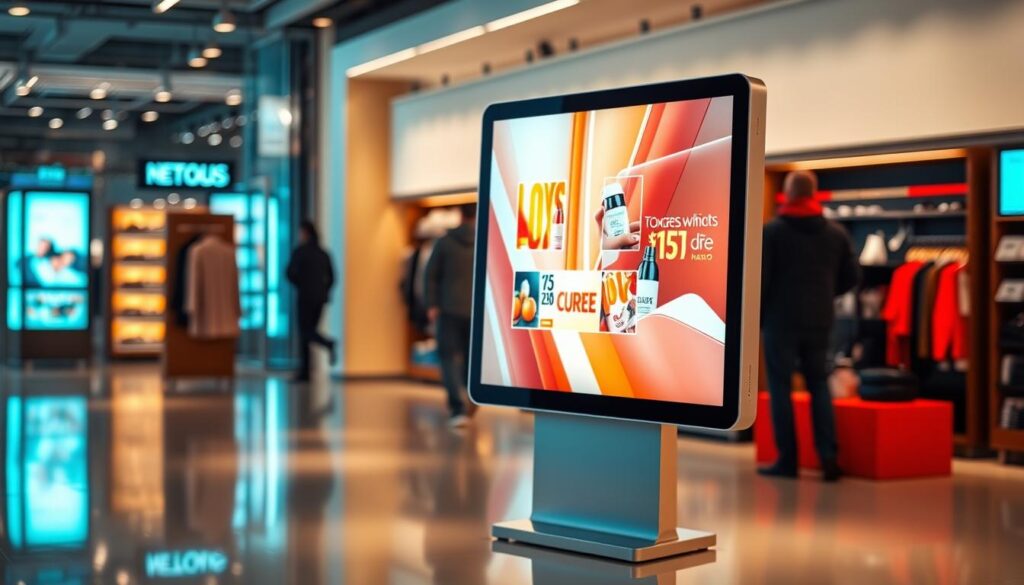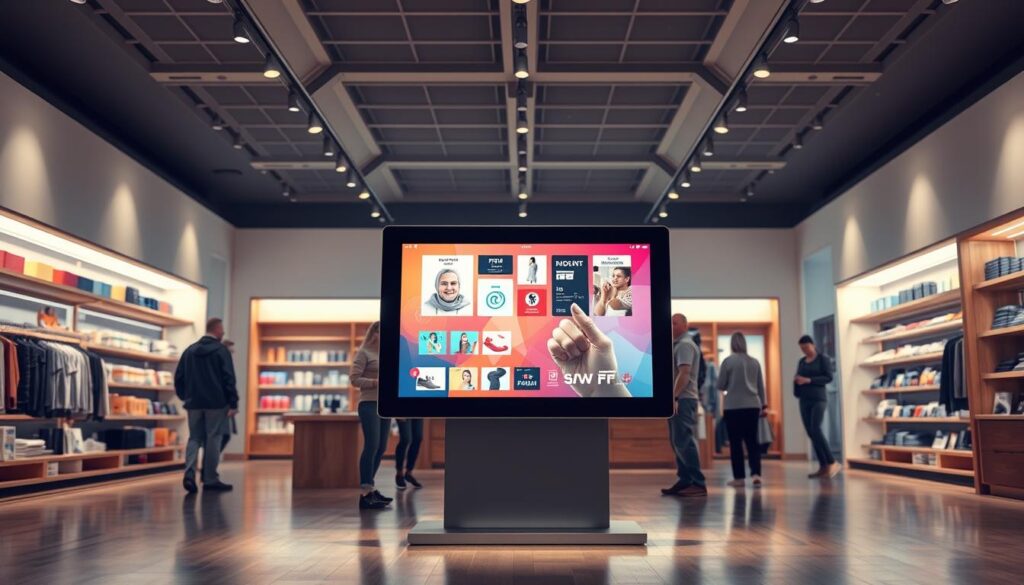Digital advertising kiosks are changing how businesses talk to customers. They are used in retail stores, healthcare facilities, and more. These interactive displays help industries like hospitality and education work better and give customers a great experience.
Unlike old ads, these kiosks use touchscreens and AI to make interactions personal. This leads to happier customers and more sales.

Retailers with digital signs see their wait times drop by 30% and order accuracy go up by 20%. These self-service tools make customers more engaged, up to 50% more, with cool features like virtual product trials.
Businesses can change their ads in real-time with data from these kiosks. This helps them make their ads better and more effective.
Old ways of advertising can’t compare to digital kiosks. Stores using them see a 200% return on investment in just a year. They save on labor and get 20% more people coming in.
High-quality screens grab people’s attention for 47 seconds, much longer than static ads. As shopping online and offline becomes more common, digital kiosks are a smart choice for today’s retailers.
Understanding the Power of Digital Advertising Kiosks
Modern digital advertising kiosk systems use the latest tech and easy design. They change how brands talk to people. These devices mix hardware like touch screen advertising kiosk interfaces with software for changing content. They are key for businesses wanting to get more people involved and make things run smoother.
What Defines a Modern Digital Advertising Kiosk
A touch screen advertising kiosk has high-quality digital signage display screens and easy touch interfaces. They can handle payments, show live data, and learn about customers. For example, McDonald’s self-service kiosks raised average order value by 20–30% by suggesting more items. Key features include:
- Multi-touch for zooming, swiping, and pinching
- Touchless for those who care about cleanliness
- Multi-screen for showing different things at once
The Evolution of Retail Advertising Technology
Retail ads moved from static posters to interactive systems. The first digital kiosks were in the 1970s at the University of Illinois. By the 1990s, places like airports and stores used kiosks for check-ins and tickets. Now, we have AI and AR, like Walmart’s in-store kiosks that cut wait times by 40%.
Key Components of Effective Digital Signage Displays
Good digital signage display setups need:
| Component | Purpose |
|---|---|
| High-brightness LCD/LED screens | Make sure people can see them outside or in bright places |
| Content Management Systems (CMS) | Help control and update content easily |
| Payment hardware | Allow for card and NFC payments |
Delta Air Lines cut counter lines by 65% with kiosks that handle payments, showing their value.
Benefits of Digital Kiosks for Retail Environments
Retailers using self-service kiosk advertising gain big advantages. These systems let customers quickly find product info, reviews, and deals on digital advertising screens. More than 80% of shoppers check out products online before buying. Kiosks bring this research into stores, making buying decisions faster and staff less busy.
81% of customers conduct online research before purchasing in-store.

Right away, you save money. Self-service kiosk advertising cuts down on labor hours for tasks like checking stock and handling payments. ProDVX’s kiosks, for instance, save on print costs by ditching brochures and signs. Their screens, from 7” to 37” with anti-glare tech, work well in any light. Big names like Target and Walmart use them to show off seasonal deals, boosting sales by 25%, reports say.
- Cut operational costs: Save up to 30% on print materials and staff time.
- Enhance customer trust: Real-time inventory updates reduce stock-out frustrations.
- Drive loyalty: Interactive screens increase dwell time by 40%, fostering deeper brand connections.
ProDVX’s systems also collect data on what customers like. Retailers find that 68% of shoppers who use kiosks spend more than those who don’t. Plus, you can update content in real-time for things like flash sales or holiday promotions without having to reprint.
ProDVX’s devices are made for constant use, so you can rely on them during busy times. Their anti-glare displays and tough hardware can handle daily use without breaking down. After 20 years of work, these tools meet today’s retail needs, from health clinics to airports.
How Interactive Marketing Solutions Transform Customer Engagement

Interactive marketing solutions are changing how brands talk to customers. Touch screen advertising kiosk technology makes people more involved, leading to stronger brand connections. Key strategies include:
- Product configurators for custom design experiences
- Virtual try-on features in beauty and apparel sectors
- Game-based loyalty programs encouraging repeat visits
Creating Memorable Brand Experiences Through Touch Screen Interaction
Stores like Sephora use interactive kiosk display systems for virtual makeup trials. This boosts trial rates by 40%. McDonald’s self-service digital kiosks increase average order values by 25% with upsell prompts. These systems grab attention with motion-activated displays and make interactions easy with gesture-based navigation.
Measuring Customer Response with Interactive Kiosk Displays
Analytics track how long people stay, touch points, and conversion rates. This data shows which promotions work best. A 2023 study found businesses using this data improve targeted marketing by 30%. Metrics like swipe rates and content interaction time help improve campaigns.
Case Studies: Successful Interactive Marketing Campaigns
A regional grocery chain used CrownTV’s touch screen advertising kiosk systems and saw a 18% increase in sales in three months. A car dealership saw a 22% rise in test drives with interactive configurators. These stories show how combining personalization with convenience leads to real results.
Self-Service Kiosk Advertising: Empowering the Modern Consumer
Self-service kiosk advertising changes how we interact with brands. These digital marketing kiosk systems let us browse, customize, and buy on our own. Today, 70% of people want to do things themselves in stores, a Nielsen report from 2024 found.
“75% of shoppers say self-service kiosks make them more likely to return to a store.” – Retail Innovation Council 2023
Big names like UVP Digital Signage and Meridian use self-service kiosk advertising to give customers power. They offer:
- Touchscreen interfaces for easy use
- Updates in real-time for deals or stock
- Custom designs for a unified look
- Tools to understand what customers like
Stores with these systems see a 32% boost in sales. Nike and SeePoint Kiosks saw a 47% increase in store visits with interactive demos. By 2030, 85% of retailers aim to grow their self-service kiosk advertising networks, saving 50% on costs.
Winnsen’s kiosks, found in airports and malls, show that giving control builds loyalty. Customers spend 2.3x more time with displays when they feel in charge. This isn’t just about being quick—it’s about building trust. As digital signage grows 23% each year, making it easy to use is key to turning lookers into buyers.
Strategic Implementation of Digital Advertising Screens
Using digital advertising screens and digital marketing kiosk systems well needs both tech know-how and understanding of people. A top retail solutions company, with over 6,000 kiosks across the country, shows how smart placement and design lead to good results. Their 4,200 digital menu boards in grocery stores show that where and when you place them matters a lot.
Dynamic displays increase brand recall by 47% compared to static signage, according to retail analytics firm ShopperMetrics.
Optimal Placement Strategies for Maximum Visibility
Where you put digital advertising screens is key. Placing them near checkout lines or entrances boosts engagement. A study by RetailNext found screens near exits cut wait times by 30% with engaging content. Here are some tips:
- Use heat maps to find busy spots
- Mount screens at eye level (58–62 inches) for best view
- Use anti-glare coatings to fight off glare
Content Creation for Digital Marketing Kiosks
Content must match what people want in the moment. A kiosk example uses 15-second ads during service breaks, getting a 70% interaction rate. Good practices include:
- Change visuals every 30 seconds to keep interest
- Add QR codes for mobile app links
- Update offers in real-time with cloud tools
Integration with Existing Marketing Channels
Working well with other marketing efforts boosts success. POS and CRM systems should share data with digital marketing kiosk systems. A big pharmacy chain saw a 23% increase in brand recognition by linking in-store screens with emails. Important steps include:
- Use APIs for instant data sharing
- Keep branding consistent online and offline
- Check analytics weekly to improve ad times
With careful planning, these steps can help retailers see up to a 30% sales boost. They can also cut costs by 50% compared to old signs.
Choosing the Right Automated Advertising Platform for Your Business
Choosing the right automated advertising platform is key to your business success. First, decide what’s most important to you. Do you want to cut down wait times, increase sales, or improve customer interaction? Automated advertising platforms like BrightSign’s media players or Samsung’s Smart Signage Platform (SSSP) cater to different needs.
For example, retail businesses looking for smooth integration might choose platforms that work well with their POS systems. This can reduce errors by up to 25%.
- Hardware specs: Choose between infrared (cost-effective) or projective capacitive (high-precision) touchscreens, with sizes ranging from 19” to 65”.
- Software flexibility: Opt for platforms like Intuiface’s no-code tools, enabling easy updates without technical expertise.
- Scalability: Verify if the system supports expansion to multiple locations or new tech like IoT devices.
“BrightSign’s dominance in digital media players stems from its reliability in high-traffic environments.”
Look at the total cost, not just the initial price. Costs include annual maintenance, which can be 15-20% of the initial cost. Choose vendors that offer analytics dashboards to track important metrics.
Make sure the platform is ADA compliant, as one in five users need accessibility features. Also, check how often the platform gets updates and how it handles security. Android-based systems might be slower to update, which can be a risk.
Compare vendors based on their support and success stories. Businesses that choose digital advertising kiosk systems with scalable architectures are ready for future trends like AI. Ask vendors about their integration with new payment systems or CRM tools.
Conclusion: Future-Proofing Your Retail Space with Digital Advertising Innovation
Digital advertising kiosks are key in today’s retail world. AI helps, like at Walmart and Amazon, boosting sales by up to 30%. Interactive kiosks, like those that recognize gestures, are becoming more common, with a 40% increase in use.
These tools lead to a 50% increase in customer interaction. This is more than traditional methods.
New trends like augmented reality (AR) and voice-activated interfaces are changing how we shop. Alibaba and JD.com use AI for smart inventory and personalized ads. They also use energy-saving screens and recyclable materials.
This makes digital kiosks good for the planet and profitable. They cut power use by 75% and reduce waste by 30%.
Platforms like Ocado’s robotic warehouses and Zalando’s AI analytics help update ads quickly. This means messages stay fresh. With 68% of people wanting brands that care about the environment, these techs meet that need.
Stores like Target and Best Buy see more people coming in with kiosks. As online shopping grows, in-store tech must keep up. Brands like Shein show how using data can lead to big success.
Retailers need to find solutions that are both new and practical. They should focus on flexible, automated platforms. This way, they can handle future tech like biometric authentication or drone delivery.
This approach not only prepares stores for the future. It also gives customers the seamless shopping experience they want, with 78% of global consumers looking for it.